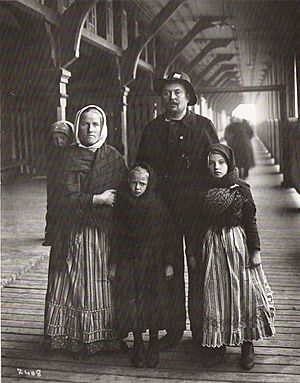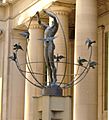Multiculturalism in Canada facts for kids

Multiculturalism in Canada is a big part of what makes Canada special. It means that people from all over the world are welcome to live in Canada. They can keep their own cultures, traditions, and languages.
Starting in the 1970s and 1980s, the Canadian government officially began to support multiculturalism. This idea became a key part of Canada's policies.
Canadians often use the word "multiculturalism" in different ways. It can describe the many religious traditions and cultural influences in the country. This mix creates what is called a "cultural mosaic" in Canada. It means the country is made up of many different people. These people come from various backgrounds, religions, and cultures.
Since Canada was formed, many people have moved there. By the early 2000s, more Canadians had backgrounds other than British or French.
Canada shows multiculturalism in many ways. For example, Canada welcomes refugees and immigrants. It does not matter what their race, religion, or culture is.
Contents
What is Multiculturalism?
Multiculturalism is the idea that many different cultures can live together peacefully. They can also share the same country. In Canada, this means celebrating differences, not just tolerating them. It helps people from different backgrounds feel like they belong.
A Cultural Mosaic
Imagine a mosaic made of many different colored tiles. Each tile is unique, but together they form a beautiful picture. Canada is like this mosaic. Each person and culture adds to the country's rich picture. This is different from a "melting pot" idea. In a melting pot, everyone is expected to blend into one main culture. In Canada, cultures keep their unique shapes and colors.
Multiculturalism in Canadian Law
Canada's commitment to multiculturalism is written into its laws. This makes it an official part of the country's identity.
The Canadian Multiculturalism Act
In 1988, Canada passed the Canadian Multiculturalism Act. This law made multiculturalism an official policy. It says that all Canadians are equal. It also says they have the freedom to keep their cultural heritage. The Act encourages all Canadians to share their cultures. It helps fight against discrimination.
Rights and Freedoms
Multiculturalism is also part of the Canadian Charter of Rights and Freedoms. This is a very important part of Canada's Constitution. Section 27 of the Charter says that courts should interpret rights in a way that respects Canada's multicultural heritage. This means that laws should consider Canada's diverse cultures.
Broadcasting and Culture
The Broadcasting Act of 1991 also supports multiculturalism. It states that Canadian television and radio should show the diversity of cultures in the country. This helps ensure that all Canadians see and hear their cultures reflected in the media. The Department of Canadian Heritage helps manage these policies.
Multiculturalism in Quebec
The province of Quebec has a slightly different approach. While it also values diversity, its official policy is called "interculturalism." This idea focuses more on bringing cultures together around a common French-speaking culture. It aims to create a shared public culture while respecting differences.
Images for kids
-
Head Tax Receipt - The head tax was introduced in 1885, as a means of controlling Chinese immigration.
-
The Dr. Sun Yat-Sen Classical Chinese Garden in Vancouver's Chinatown is the first full-size Chinese or "scholars" garden built outside of China.
-
Monument to Multiculturalism by Francesco Pirelli in Toronto, Ontario, Canada. Four identical sculptures are located in Buffalo City, South Africa; Changchun, China; Sarajevo, Bosnia and Herzegovina; and Sydney, Australia.
-
The Global Centre for Pluralism is located in Ottawa on Sussex Drive at the former location of the Canadian War Museum.
See also
 In Spanish: Multiculturalismo en Canadá para niños
In Spanish: Multiculturalismo en Canadá para niños







